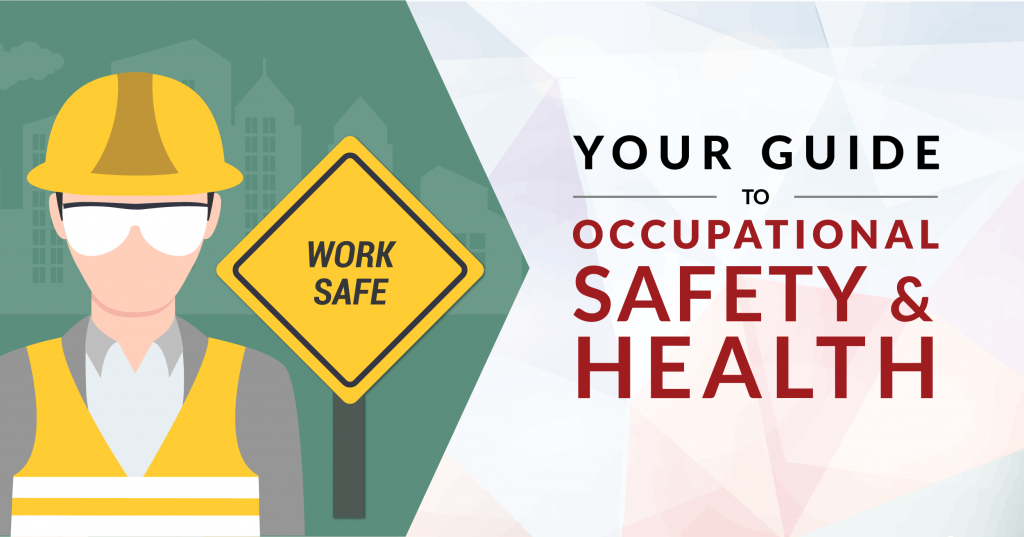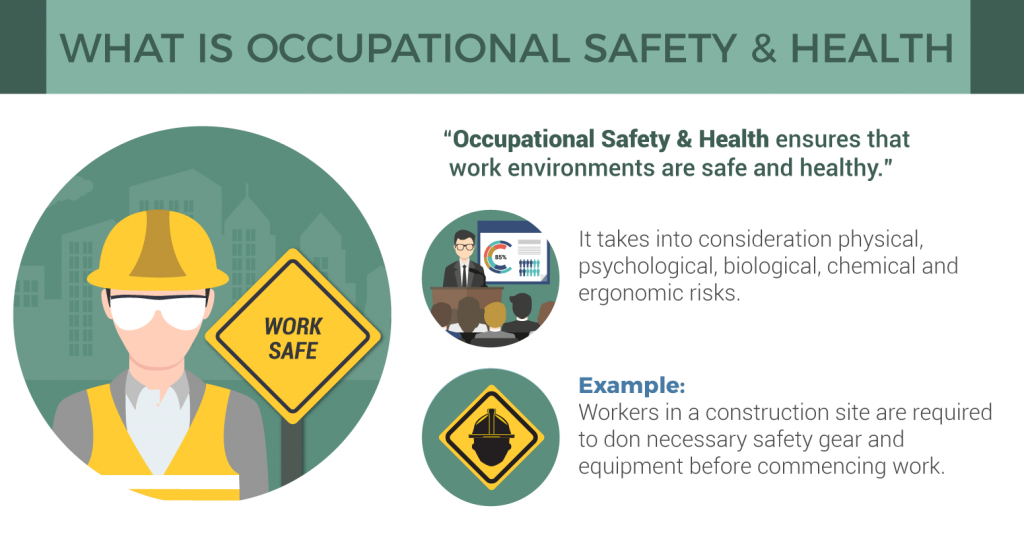The Complete Guide to Studying Occupational Safety & Health in Malaysia
How to be a certified occupational safety & health officer in Malaysia? Start by studying the course! Check out requirements, fees and where to study here.

Did you know that there were over 21,534 work-related accidents reported in Malaysia in 2021, of which 301 were deaths?
And these are just the cases that were investigated by the Department of Occupational Safety and Health (DOSH). What about those that were not investigated?
This is exactly why Occupational Safety and Health plays such a pivotal role in the workplace – ensuring that relevant safety and health standards, as well as procedures, are carefully observed to reduce potential occupational hazards.
If you’re passionate about playing your part in protecting the lives of hardworking workers and combating the rising rate of occupational accidents, then make further inspections on why Occupational Safety & Health may be the right course for you.
#1. The Basics of Occupational Safety & Health
a) What Is Occupational Safety & Health?

Occupational Safety & Health (OSH) is responsible for making sure that working environments are safe and healthy.
Some of the major responsibilities of OSH officers include designing safe working procedures, performing working site inspections as well as providing necessary training on various workplace safety, health and risk-related issues.
A simple case in point is that workers at a construction site are required to don all the necessary safety gear and equipment, such as safety glasses, gloves, hard hats and safety vests, not to mention checking off a set of long safety checklists before they are allowed to commence work.
Occupational Safety & Health doesn’t just cover physical safety conditions. It also takes into consideration other sneaky hazards like psychological (stress and strain), biological (infestations, bacteria and viruses), chemical (dusts, fumes and gases) and ergonomic (badly-designed machinery and workstations) risks, all which are crucial to the overall physical, mental and social wellbeing of employees at the workplace.

City University
Bachelor of Occupational Safety & Health (Hons)
✓Focuses on delivering health, safety, and hygiene training
#2. Studying an Occupational Safety & Health Course
a) Entry Requirements & Qualifications
In order to pursue an Occupational Safety & Health course, you will need to meet the minimum requirements set by colleges and universities.
(i) Diploma in Occupational Safety & Health
In general, the minimum entry requirements for a Diploma in Occupational Safety & Health course are:
- SPM: Minimum 3Cs including Mathematics and one Science subject (Biology, Physics, Chemistry, General Science), plus a pass in English
A typical Occupational Safety & Health Diploma will take 2.5 – 3 years to complete. Not only you will be taught how to assess and measure the safety and health of various workplaces, you will also learn how to set up necessary safety and health conditions to ensure the wellbeing of workers.
Upon completion of your diploma, you will be able to demonstrate an understanding of safety and health in the workplace and apply your knowledge and skills to prevent accidents and workplace injuries.
After completing your Diploma in Occupational Safety & Health, you can look for suitable employment opportunities to put your newly acquired knowledge to practice. In case you feel you need a more comprehensive understanding of the field, you can choose to pursue a Degree in Occupational Safety & Health.
(ii) Degree in Occupational Safety & Health
To pursue a Degree in Occupational Safety & Health, you will need to complete your SPM (or an equivalent qualification) and a Pre-University qualification first.
Of course, you’ll need to meet the minimum entry requirements set by your desired university or college as well. Here are the general requirements for a Degree in Occupational Safety & Health:
- A-Level: Minimum 2Ds in TWO of the following subjects (Biology, Physics or Mathematics, Chemistry); or
- STPM: Minimum 2Cs including one science subject (Biology, Physics, Chemistry, General Science); or
- Diploma: Minimum CGPA of 2.75; or
- Foundation in Science: Minimum CGPA of 2.33
Not only that, you will also need to meet English requirements by obtaining MUET Band 3 or IELTS 5.5.
PRO TIP
Do conduct the necessary research first as entry requirements may be higher depending on the college or university.
A Degree in Occupational Safety & Health is generally 3 - 4 years long.
Upon completion of an Occupational Safety & Health Degree, you will gain a stronger grasp on fundamental and professional occupational safety and health topics. You will also be able to make more comprehensive interpretations and analyses to recommend suitable preventive measures in the workplace.
More importantly, with a Degree in Occupational Safety & Health in hand, you can also advise, educate and train employees, employers and even the community on various issues related to workplace safety and health.

b) How Does Your Education Pathway Look Like?

In general, most people pursuing an Occupational Safety & Health course will go on to become Safety and Health Officers (SHO).
In order to be a registered competent Safety and Health Officer that is licensed by the Department of Occupational Safety & Health (DOSH), there are several pathways you can consider.
To start, after your SPM, you can take up a Pre-University course, a Foundation in Science or a Diploma in Occupational Safety & Health course.
Upon completion of your Pre-University or Foundation programme, you can then continue on to a Degree in Occupational Safety & Health.
For Diploma graduates, you will have the option to seek relevant employment opportunities to score some valuable work experience first, pursue your license as a competent Safety and Health Officer or further your studies with a Degree in Occupational Health & Safety.
PRO TIP
If you desire to move up the ranks and join a higher income bracket as an Occupational Safety and Health Officer, you may need to obtain higher qualifications (e.g. diploma, degree, postgraduate studies, National Examination Board in Occupational Safety and Health (NEBOSH) or Certified Safety Professional (CSP), etc.) on top of chalking up the relevant working experience.
To be a registered competent Safety and Health Officer with the Department of Occupational Safety & Health, you will need to:
- Attend a Safety and Health Officer course and pass the exam*
- Obtain at least 3 years of working experience related to the occupational safety and health field
- Pass a verification session conducted by the Department of Occupational Safety and Health (DOSH), if requested
PRO TIP
If you take an Occupational Safety & Health course with an institution that's recognised by DOSH, you will be exempted from taking the Safety and Health Officer course.
c) What Will You Study in Occupational Safety & Health?

You will be exposed to fundamental science subjects such as human anatomy, microbiology, basic psychology and physics. These will serve as your foundation before taking up specific occupational safety and health-related subjects, which include:
- Occupational Safety and Health Laws
- OSH Risk Management
- Emergency Response and Planning
- Hazardous Substances
- Fire, Chemical and Machinery Safety
- Occupational Epidemiology
- Ergonomics and Human Factor
- Accident Investigation
- Business Operations Management
As part of your degree, you will also need to commit to a final year project and industrial training to complement your learning in classes.

City University
Foundation in Business
✓Modules tailored to prepare you for degrees in business administration, accounting and finance
#3. Why Should You Study Occupational Safety & Health?

With so many popular courses like Medicine, Engineering, Law, Psychology and Business, why should you consider taking up an Occupational Safety & Health course?
Here are some reasons to give this course a good thought.
(a) Flexibility to explore multiple industries
Occupational safety and health professionals can find employment opportunities in a wide variety of settings, such as construction, factories, petrochemical, mining and offices.
As long as there is a risk in the safety and health of employees, tenants or guests, your expertise in this field will be needed. After all, not only do workplace accidents cost businesses money via compensation and fines, they are also a source of bad publicity and low staff morale.
So if you’re looking for a relatively flexible career that’s sought after by multiple industries, then you should give this field due consideration.
(b) Be a part of the health frontline
While you may not be directly involved in saving lives, you will be part of the health heroes toiling tirelessly to prevent workplace accidents from occurring, thus reducing fatalities and the need for people to seek medical aid.
So if you fancy being part of the health frontline but prefer a career that’s a little less mainstream, Occupational Safety & Health can be a great choice for you!
(c) Ensure safe and healthy working conditions for all
Every year, thousands of workplace accidents are recorded, with many resulting in injury, permanent disability, or worse, death. Many of these could have been avoided had there been proper occupational safety and health information, training and processes in place.
If you feel strongly about these numbers and would like to do your part in helping people avoid mishaps at work, then studying Occupational Safety & Health is a great place to start.

#4. What Skills Do You Need for an Occupational Safety & Health Course?

As a profession that upholds the safety and health of those around you, you will need to maintain a high level of professionalism and work ethic, on top of having a specific set of skills to perform well in your course as well as at work.
(a) Strong critical thinking skills
Every working environment will be different from another, so be prepared to face challenges that are very dynamic in nature. For example, a shoe production factory can have very different safety and health procedures and standards compared to a chocolate factory.
Your critical thinking skills will be put to test as you assess, analyse and customise feasible safety and health solutions based on the needs of different workplace environments.
(b) Ability to practice and maintain active listening
Many clues in your initial diagnoses and assessments of the safety of a workplace come from existing employees.
The ability to be able to engage and obtain valuable feedback from people whose health and wellbeing are directly involved can be an important attribute of a safety and health officer.
Expect to be tested on your ability to listen and acquire feedback in classes.
(c) Ability to articulate and communicate well with others
As a safety and health officer, not only do you need to ensure that all the safety procedures are in place, you will also be expected to carry out lectures or training sessions to educate employees.
Inevitably, you will be trained to give detailed presentations in your Occupational Safety & Health course, as good articulation and presentation skills are needed in this field.

City University
Bachelor of Occupational Safety & Health (Hons)
✓Focuses on delivering health, safety, and hygiene training
#5. What Career Options Do You Have with an Occupational Safety & Health Degree?
Well equipped with the right knowledge and relevant qualifications, graduates of an Occupational Safety & Health course can kick-start their careers as:
- OSH Specialist
- Health Inspector
- Safety Officer
- Trainer
- Hygiene Technician
Occupational safety and health is a broad field as it needs to cover all dynamics of the working environment. Passing the respective competency courses and assessments, on top of chalking up the required working experience, will allow you to be licensed as a competent person accordingly.
Based on the Department Occupational Safety & Health’s (DOSH) website, there are specific types of competent personnel involved for specific matters.
| Assessor | Performs chemical health risk assessments |
| Gas Tester | Carries out atmosphere tests in a confined space (e.g. room) |
| Hygiene Technician 1 | Monitors chemical exposure |
| Hygiene Technician 2 | Carries out inspections and examinations on engineering test equipment |
| Indoor Air Quality Assessor | Performs assessments of indoor air quality |
| Lift Competent Person | Responsible for designing, constructing, installing and testing of lifts |
| Major Hazard Competent Person | Provides major hazard control consultations to employers |
| Noise Competent Person | Monitors noise exposure |
| Responsible Person | Responsible for erecting, maintaining and dismantling hoisting machines, tower cranes and gondola |
| Occupational Health Doctor | Performs medical and health surveillance |
| Safety and Health Officer | Employed exclusively at the place of work to perform and manage safety and health-related matters |
| Safety Site Supervisor | Employed exclusively at construction sites to perform safety supervision |
| Steam / Internal Combustion Engine Engineer | Responsible for operating and taking charge of steam or internal combustion engines |
Occupational Safety & Health graduates are usually in-demand in most heavy industries in Malaysia. Here are some major industries that are always on a lookout for OSH graduates.
- Manufacturing
- Mining and quarrying
- Agriculture, forestry and fishing
- Utilities (e.g. electricity, oil and gas, water and sanitary services)
- Transport, storage and communication
- Wholesale and retail trades
- Hotels and restaurants
- Finance, insurance, real estate and business services
- Public services and statutory bodies
- Training
- Construction
#6. Where Can You Study Occupational Safety & Health in Malaysia?
Interested in pursuing a career in the Occupational Safety & Health field? For a start, here are some top institutions for Occupational Safety & Health in Malaysia that you can consider.
City University
Petaling Jaya, Selangor
Bachelor of Occupational Safety & Health (Hons)
Intake
Jan, May, Sep
Tuition Fees
RM60,000




